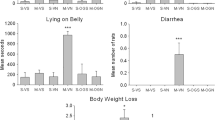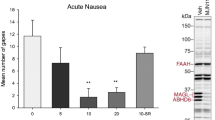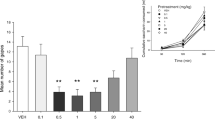Abstract
Rationale
The fatty acid amide oleoyl glycine (OlGly) and its more stable methylated form oleoyl alanine (OlAla) reduce naloxone-precipitated morphine withdrawal (MWD)-induced conditioned gaping (nausea) responses in rats. In addition, OlGly has been shown to reduce lithium chloride (LiCl)–induced conditioned gaping in rats and vomiting in Suncus murinus (house musk shrews).
Objectives
Here, we compared the potential of these fatty acid amides to maintain their anti-nausea/anti-emetic effect over a delay. The following experiments examined the potential of a wider dose range of OlGly and OlAla to interfere with (1) LiCl-induced conditioned gaping in rats and (2) LiCl-induced vomiting in shrews, when administered 20 or 70 min prior to illness.
Results
OlAla (1, 5, 20 mg/kg) reduced LiCl-induced conditioned gaping, with OlGly only effective at the high dose (20 mg/kg), with no effect of pretreatment delay time. At the high dose of 20 mg/kg, OlGly increased passive drips during conditioning suggesting a sedative effect. In shrews, both OlGly and OlAla (1, 5 mg/kg) suppressed LiCl-induced vomiting, with no effect of pretreatment delay. OlAla more effectively suppressed vomiting, with OlAla (5 mg/kg) also increasing the latency to the first vomiting reaction.
Conclusions
OlAla was more effective than OlGly in reducing both LiCl-induced gaping in rats and LiCl-induced vomiting in shrews. These findings provide further evidence that these fatty acid amides may be useful treatments for nausea and vomiting, with OlAla demonstrating superior efficacy.


Similar content being viewed by others
Abbreviations
- ANOVA:
-
Analysis of variance
- CB1 :
-
Cannabinoid 1
- CPA:
-
Conditioned place aversion
- CPP:
-
Conditioned place preference
- F:
-
Female
- FAAH:
-
Fatty acid amide hydrolase
- ip:
-
Intraperitoneal
- LiCl:
-
Lithium chloride
- M:
-
Male
- MWD:
-
Morphine withdrawal
- OlAla:
-
Oleoyl alanine
- OlGly:
-
Oleoyl glycine
- PPARα:
-
Peroxisome proliferator-activated receptor alpha
- sem:
-
Standard error of the mean
- TR:
-
Taste reactivity
- VEH:
-
Vehicle
References
Ayoub SM, Smoum R, Farag M, Atwal H, Collins SA, Rock EM, Limebeer CL, Piscitelli F, Iannotti FA, Lichtman AH, Leri F, Di Marzo V, Mechoulam R, Parker LA (2020) Oleoyl alanine (HU595): a stable monomethylated oleoyl glycine interferes with acute naloxone precipitated morphine withdrawal in male rats. Psychopharmacology 237:2753–2765. https://doi.org/10.1007/s00213-020-05570-4
Ayoub SM, Piscitelli F, Silvestri C, Limebeer CL, Rock EM, Smoum R, Farag M, de Almeida H, Sullivan MT, Lacroix S, Boubertakh B, Nallabelli N, Lichtman AH, Leri F, Mechoulam R, Di Marzo V, Parker LA (2021) Spontaneous and naloxone-precipitated withdrawal behaviors from chronic opiates are accompanied by changes in N-oleoylglycine and N-oleoylalanine levels in the brain and ameliorated by treatment with these mediators. Front Pharmacol. 12:706703. https://doi.org/10.3389/fphar.2021.706703
Bradshaw HB, Rimmerman N, Hu SS, Benton VM, Stuart JM, Masuda K, Cravatt BF, O’Dell DK, Walker JM (2009a) The endocannabinoid anandamide is a precursor for the signaling lipid, N-arachidonoyl glycine through two distinct pathways. BMC Biochem 10:14. https://doi.org/10.1186/1471-2091-10-14
Bradshaw HB, Rimmerman N, Hu SS, Burstein S, Walker JM (2009b) Novel endogenous N-acyl glycines identification and characterization. Vitam Horm 81:191–205. https://doi.org/10.1016/S0083-6729(09)81008-X
Chaturvedi S, Driscoll WJ, Elliot BM, Faraday MM, Grunberg NE, Mueller GP (2006) In vivo evidence that N-oleoylglycine acts independently of its conversion to oleamide. Prostaglandins Other Lipid Mediat 81:136–149. https://doi.org/10.1016/j.prostaglandins.2006.09.001
Cross-Mellor SK, Ossenkopp KP, Piomelli D, Parker LA (2007) Effects of the FAAH inhibitor, URB597, and anandamide on lithium-induced taste reactivity responses: a measure of nausea in the rat. Psychopharmacology 190:135–143. https://doi.org/10.1007/s00213-006-0589-7
Donvito G, Piscitelli F, Muldoon P, Jackson A, Vitale RM, D'Aniello E, Giordano C, Ignatowska-Jankowska BM, Mustafa MA, Guida F, Petrie GN, Parker L, Smoum R, Sim-Selley L, Maione S, Lichtman AH, Damaj MI, Di Marzo V, Mechoulam R (2019) N-oleoyl-glycine reduces nicotine reward and withdrawal in mice. Neuropharmacology. 148:320–331. https://doi.org/10.1016/j.neuropharm.2018.03.020
Grill HJ, Norgren R (1978) The taste reactivity test. I Mimetic responses to gustatory stimuli in neurologically normal rats. Brain Res 143:263–279. https://doi.org/10.1016/0006-8993(78)90568-1
Limebeer CL, Vemuri VK, Bedard H, Lang ST, Ossenkopp KP, Makriyannis A, Parker LA (2010) Inverse agonism of cannabinoid CB1 receptors potentiates LiCl-induced nausea in the conditioned gaping model in rats. Br J Pharmacol 161:336–349. https://doi.org/10.1111/j.1476-5381.2010.00885.x
Merkler DJ, Chew GH, Gee AJ, Merkler KA, Sorondo JPO, Johnson ME (2004) Oleic acid derived metabolites in mouse neuroblastoma N18TG2 cells. Biochemistry 43:12667–12674. https://doi.org/10.1021/bi049529p
Parker LA (2014) Conditioned flavor avoidance and conditioned gaping: rat models of conditioned nausea. Eur J Pharmacol 722:122–133. https://doi.org/10.1016/j.ejphar.2013.09.070
Parker LA, Kwiatkowska M, Burton P, Mechoulam R (2004) Effect of cannabinoids on lithium-induced vomiting in the Suncus murinus (house musk shrew). Psychopharmacology 171:156–161. https://doi.org/10.1007/s00213-003-1571-2
Parker LA, Limebeer CL, Rock EM, Litt DL, Kwiatkowska M, Piomelli D (2009) The FAAH inhibitor URB-597 interferes with cisplatin- and nicotine-induced vomiting in the Suncus murinus (house musk shrew). Physiol Behav 97:121–124. https://doi.org/10.1016/j.physbeh.2009.02.014
Parker LA, Limebeer CL, Rock EM, Sticht MA, Ward J, Turvey G, Benchama O, Rajarshi G, Wood JT, Alapafuja SO, Makriyannis A (2016) A comparison of novel, selective fatty acid amide hydrolase (FAAH), monoacyglycerol lipase (MAGL) or dual FAAH/MAGL inhibitors to suppress acute and anticipatory nausea in rat models. Psychopharmacology 233:2265–2275. https://doi.org/10.1007/s00213-016-4277-y
Petrie GN, Wills KL, Piscitelli F, Smoum R, Limebeer CL, Rock EM, Humphrey AE, Sheppard-Perkins M, Lichtman AH, Mechoulam R, Di Marzo V, Parker LA (2019) Oleoyl glycine: interference with the aversive effects of acute naloxone-precipitated MWD, but not morphine reward, in male Sprague-Dawley rats. Psychopharmacology 236:2623–2633. https://doi.org/10.1007/s00213-019-05237-9
Raboune S, Stuart JM, Leishman E, Takacs SM, Rhodes B, Basnet A, Jameyfield E, McHugh D, Widlanski T, Bradshaw HB (2014) Novel endogenous N-acyl amides activate TRPV1-4 receptors, BV-2 microglia, and are regulated in brain in an acute model of inflammation. Front Cell Neurosci 8:195. https://doi.org/10.3389/fncel.2014.00195
Rankin L, Fowler CJ (2020) The basal pharmacology of palmitoylethanolamide. Int J Mol Sci 21:7942. https://doi.org/10.3390/ijms21217942
Rock EM, Limebeer CL, Ward JM, Cohen A, Grove K, Niphakis MJ, Cravatt BF, Parker LA (2015) Interference with acute nausea and anticipatory nausea in rats by fatty acid amide hydrolase (FAAH) inhibition through a PPARα and CB1 receptor mechanism, respectively: a double dissociation. Psychopharmacology 232:3841–3848. https://doi.org/10.1007/s00213-015-4050-7
Rock EM, Moreno-Sanz G, Limebeer CL, Petrie GN, Angelini R, Piomelli D, Parker LA (2017) Suppression of acute and anticipatory nausea by peripherally restricted fatty acid amide hydrolase inhibitor in animal models: role of PPARα and CB1 receptors. Br J Pharmacol 174:3837–3847. https://doi.org/10.1111/bph.13980
Rock EM, Limebeer CL, Aliasi-Sinai L, Parker LA (2019) The ventral pallidum as a critical region for fatty acid amide hydrolase inhibition of nausea-induced conditioned gaping in male Sprague-Dawley rats. Neuropharmacology. 155:142–149. https://doi.org/10.1016/j.neuropharm.2019.05.031
Rock EM, Ayoub SM, Limebeer CL, Gene A, Wills KL, DeVuono MV, Smoum R, Di Marzo V, Lichtman AH, Mechoulam R, Parker LA (2020a) Acute naloxone-precipitated morphine withdrawal elicits nausea-like somatic behaviors in rats in a manner suppressed by N-oleoylglycine. Psychopharmacology 237:375–384. https://doi.org/10.1007/s00213-019-05373-2
Rock EM, Sullivan MT, Collins SA, Goodman H, Limebeer CL, Mechoulam R, Parker LA (2020b) Evaluation of repeated or acute treatment with cannabidiol (CBD), cannabidiolic acid (CBDA) or CBDA methyl ester (HU-580) on nausea and/or vomiting in rats and shrews. Psychopharmacology 237:2621–2631. https://doi.org/10.1007/s00213-020-05559-z
Takao K, Noguchi K, Hashimoto Y, Shirahata A, Sugita Y (2015) Synthesis and evaluation of fatty acid amides on the N-oleoylethanolamide-like activation of peroxisome proliferator activated receptor α. Chem Pharm Bull (Tokyo) 63:278–285. https://doi.org/10.1248/cpb.c14-00881
Thabuis C, Tissot-Favre D, Bezelgues JB, Martin JC, Cruz-Hernandez C, Dionisi F, Destaillats F (2008) Biological functions and metabolism of oleoylethanolamide. Lipids. 43:887–894. https://doi.org/10.1007/s11745-008-3217-y
Wang S, Xu Q, Shu G, Wang L, Gao P, Xi Q, Zhang Y, Jiang Q, Zhu X (2015) N-oleoyl glycine, a lipoamino acid, stimulates adipogenesis associated with activation of CB1 receptor and Akt signaling pathway in 3T3-L1 adipocyte. Biochem Biophys Res Commun 466:438–443. https://doi.org/10.1016/j.bbrc.2015.09.046
Funding
The research described here was funded by research grants from the Natural Sciences and Engineering Council of Canada (NSERC: 03629) and Canadian Institutes of Health Research (CIHR: 388239).
Author information
Authors and Affiliations
Corresponding author
Ethics declarations
Conflict of interest
The authors declare no competing interests.
Additional information
Publisher’s note
Springer Nature remains neutral with regard to jurisdictional claims in published maps and institutional affiliations.
Rights and permissions
About this article
Cite this article
Rock, E.M., Limebeer, C.L., Smoum, R. et al. Effect of oleoyl glycine and oleoyl alanine on lithium chloride induced nausea in rats and vomiting in shrews. Psychopharmacology 239, 377–383 (2022). https://doi.org/10.1007/s00213-021-06005-4
Received:
Accepted:
Published:
Issue Date:
DOI: https://doi.org/10.1007/s00213-021-06005-4




